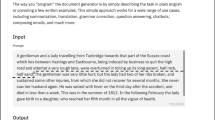Abstract
Natural dialogue does not proceed haphazardly; it has an easily recognized “episodic” structure and coherence which conform to a well developed set of conventions. This paper represents these conventions formally in terms related to speech act theory and to a theory of action.
The major formal unit, the dialogue game, specifies aspects of the communication of both participants in a dialogue. We define the formal notion of dialogue games, and describe some of the important games of English. Dialogue games are conventions of interactive goal pursuit. Using them, each participant pursues his own goals in a way which sometimes serves the goals of the other. The idea of dialogue games can thus be seen as a part of a broader theoretical perspective which characterizes virtually all communication as goal pursuit activity.
We also define and exemplify the property of Motivational Coherence of dialogues. Motivational Coherence can be used as an interpretive principle in explaining language comprehension.
Actual dialogue games have a kind of causal connectedness which is not a consequence of their formal properties. This is explained in terms of a theory of action, which is also seen to explain a similar attribute of speech acts.
Similar content being viewed by others
References
Allen, James, 1978: ‘Recognizing Intention in Dialogue’, Ph.D. Thesis, University of Toronto.
Austin, J. L.: 1962, How to Do Things with Words, Harvard University Press, Cambridge.
Brown, Gretchen P.: 1979, ‘Towards a Computational Theory of Indirect Speech Acts’, Massachusetts Institute of Technology, Technical Report, MIT/LCS/TR-223.
Carlson, Lauri: 1983, Dialogue Games: An Approach to Discourse Analysis, Reidel, Dordrecht, Holland.
Cohen, Philip R. and Hector J. Levesque: 1985, ‘Speech Acts and Rationality’, in Proceedings of the 23rd Annual Meeting of the Association for Computational Linguistics, Association for Computational Linguistics, pp. 49–59.
Cohen, Philip R. and C. Raymond Perrault: 1977, ‘Overview of Planning Speech Acts’, in Proceedings of the Fifth International Joint Conference on Artificial Intelligence, Massachusetts Institute of Technology.
Cohen, Philip R. and C. Raymond Perrault: 1979, ‘Elements of a Plan-Based Theory of Speech Acts’, Cognitive Science 3.
Davison, Alice: 1975, ‘Indirect Speech Acts and What to Do with Them’, in P. Cole and J. L. Morgan (eds.), Syntax and Semantics, Vol. 3, Speech Acts, Academic Press, New York, pp. 143–185.
De Beaugrande, Robert: 1978, ‘Text and Sentence in Discourse Planning’, in J. S. Petofi (ed.), Text vs. Sentence: Basic Questions of Text Linguistics, Buske, Hamburg, pp. 467–494.
Eemeren, F. van and R. Grootendorst: 1982, ‘The Speech Acts of Arguing and Convincing in Externalized Discussions ’, Journal of Pragmatics 6, 1–24.
Ferrara, A.: 1980a, ‘An Extended Theory of Speech Acts: Appropriateness Conditions for Subordinate Acts in Sequences’, Journal of Pragmatics 4, 233–252.
Ferrara, A.: 1980b, ‘Appropriateness conditions for entire sequences of speech acts’, Journal of Pragmatics 4, 321–340.
Grosz, Barbara J.: 1977, ‘The Representation and Use of Focus in Dialog Understanding’, Ph.D. Thesis, University of California, Berkeley.
Grosz, Barbara J. and Candace L. Sidner: 1986, ‘Attention, Intentions and the Structure of Discourse’, Computational Linguistics 12, 3, 175–204.
Heringer, James: 1972, ‘Some Grammatical Correlates of Felicity Conditions and Pre—suppositions’, in Working Papers in Linguistics 11, The Ohio State University Department of Linguistics, Columbus.
Levin, James, A. and James A. Moore: 1977, ‘Dialogue-Games: Meta-Communication Structures for Natural Language Interaction’, Cognitive Science 1, 4.
Mann, William C.: 1975, ‘Dialogue Based Research in Man-Machine Communication’, USC/Information Sciences Institute, Technical Report, ISI/RR-75–41, Marina del Rey, CA.
Mann, William C.: 1977a, ‘Man-Machine Communication Research’, USC/Information Sciences Institute, Final Report, ISI/RR-77–57, Marina del Rey, CA.
Mann, William C., James A. Moore and James A. Levin: 1977b, ‘A Comprehension Model for Human Dialogue’, in Proceedings of the Fifth International Joint Conference on Artificial Intelligence, Massachusetts Institute of Technology, pp. 77–87.
Mann, William C.: 1979, ‘Dialogue Games’, USC/Information Sciences Institute, Technical Report, ISI/RR-79–77, Marina del Rey, CA.
Mann, William C., James A. Moore, James A. Levin and James H. Carlisle: 1975, ‘Observation Methods for Human Dialogue’, USC/Information Sciences Institute, Technical Report, ISI/RR-75–33. Marina del Rey, CA.
Mann, William C., James H. Carlisle, James A. Moore and James A. Levin: 1977, ‘An Assessment of Reliability of Dialogue-Annotation Instructions’, USC/Information Sciences Institute, Technical Report, ISI/RR-77–54. Marina del Rey, CA.
Minsky, Marvin A.: 1975, ‘A Framework for Representing Knowledge’, in P. H. Winston (ed.), The Psychology of Computer Vision, McGraw-Hill, New York.
Moore, James A., James A. Levin and William C. Mann: 1977, ‘A Goal-Oriented Model of Human Dialogue’, American Journal of Computational Linguistics, Microfiche 67.
Moore, Robert: 1980, ‘Reasoning About Knowledge and Action’, SRI International Artificial Intelligence Center, Technical Note 191, Menlo Park, CA.
Perrault, C. Raymond and Philip R. Cohen: 1978, ‘Planning Speech Acts’, University of Toronto Department of Computer Science, Technical Report.
Rogers, Andy: 1978, ‘Remarks on the Analysis of Assertion and the Conversational Role of Speech Acts’, in Proceedings of the Fourth Annual Meeting of the Berkeley Linguistics Society, Berkeley, CA.
Schank, Roger C. and Robert P. Abelson: 1975, ‘Scripts, Plans and Knowledge’, in Proceedings of the Fourth International Joint Conference on Artificial Intelligence, Tbilisi, Georgia, U.S.S.R., pp. 151–157.
Searle, John R.: 1969, Speech Acts: An Essay in the Philosophy of Language, Cambridge University Press, Cambridge, England.
Searle, John R.: 1975, ‘Indirect Speech Acts’, in P. Cole and J. L. Morgan (eds.), Syntax and Semantics, Vol. 3, Speech Acts, Academic Press, New York, pp. 59–82.
Stalnaker, Robert C.: 1978, ‘Assertion’, in P. Cole (ed.), Syntax and Semantics, Vol. 9, Pragmatics, Academic Press, New York, pp. 315–332.
Winograd, Terry: 1975, ‘Representing Knowledge: Frames, ‘Oral Presentation at the Conference on Theoretical Issues in Natural Language Processing’, Cambridge, MA.
Author information
Authors and Affiliations
Rights and permissions
About this article
Cite this article
Mann, W.C. Dialogue games: Conventions of human interaction. Argumentation 2, 511–532 (1988). https://doi.org/10.1007/BF00128990
Issue Date:
DOI: https://doi.org/10.1007/BF00128990



